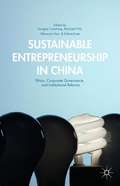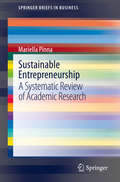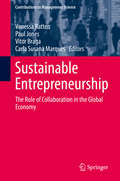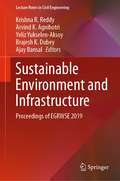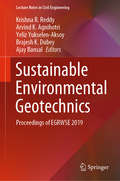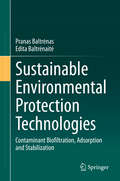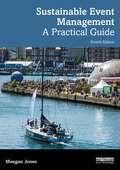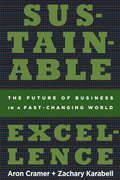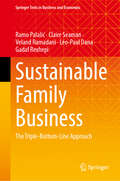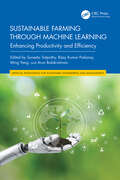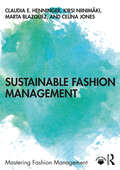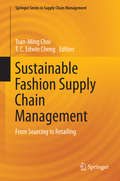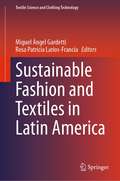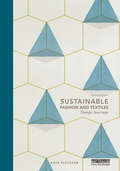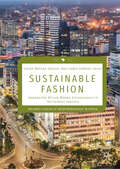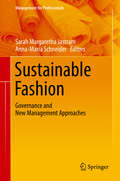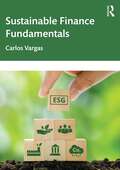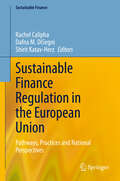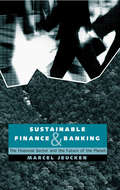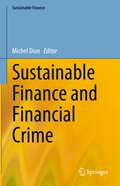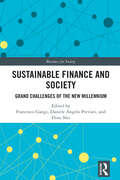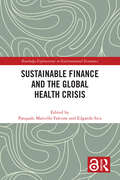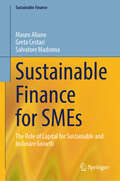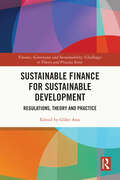- Table View
- List View
Sustainable Entrepreneurship in China
by Edward Lee Douglas Cumming Wenxuan Hou Michael FirthThere is an intense love–hate relationship between entrepreneurship and business ethics, and transitional economies provide fertile ground to examine these issues, especially within emerging markets. While institutional reform and governance assist entrepreneurship, the competition among Chinese entrepreneurs also serves as catalysts for further reform and governance improvement. Therefore, there is an interrelationship between business ethics, entrepreneurship, corporate governance,and institutional reform associated with China's past, current, and future economic development. Sustainable Entrepreneurship in China provides empirical evidence and cutting-edge research into topical business ethics issues relating to entrepreneurship, corporate governance, and institutional reforms in China. As a leading emerging economy, analysis of Chinese data provides useful policy implications for China, as well as other developing economies, on the ethical aspects of talent acquisition, venture capital investment, and corporate governance.
Sustainable Entrepreneurship: A Systematic Review of Academic Research (SpringerBriefs in Business)
by Mariella PinnaThis book examines the current body of knowledge on sustainable entrepreneurship. Using network and content analysis, the author maps the structure of the research field and provides a systematic review. In this regard, network analysis is used to find evidence of thematically related clusters of publications and polarizing differences across the subfields of inquiry. In contrast, content analysis is employed to identify and address emerging gaps in the literature. In particular, after discussing mainstream contributions, the author focuses on pioneering research and predicts possible paths that might challenge researchers in the future. The author contributes to the ongoing debate on the definition and boundaries of the flourishing field of sustainable entrepreneurship, by offering critical insights and possible future development pathways derived from both quantitative and qualitative analyses.
Sustainable Entrepreneurship: The Role Of Collaboration In The Global Economy (Contributions to Management Science)
by Paul Jones Vanessa Ratten Vitor Braga Carla Susana MarquesSustainable entrepreneurship focuses on how the environment is embedded within business practices. This book examines collaboration strategies and initiatives for sustainable entrepreneurs with a wide variety of partners, and demonstrates how they can be used to increase overall performance and achieve global competitiveness. Based on the latest empirical evidence from emerging economies, the book’s respective chapters address sustainability issues in connection with knowledge creation and learning, outsourcing, and the roles of universities, consultants, and the public sector.
Sustainable Environment and Infrastructure: Proceedings of EGRWSE 2019 (Lecture Notes in Civil Engineering #90)
by Krishna R. Reddy Ajay Bansal Arvind K. Agnihotri Yeliz Yukselen-Aksoy Brajesh K. DubeyThis volume contains selects papers presented during the 2nd International Conference on Environmental Geotechnology, Recycled Waste Materials and Sustainable Engineering, held in the University of Illinois at Chicago. It covers the recent innovations, trends, and concerns, practical challenges encountered, and the solutions adopted in waste management and engineering, geotechnical and geoenvironmental engineering, infrastructure engineering, and sustainable engineering. This book will be useful for academics, educators, policy makers and professionals working in the field of civil engineering, chemical engineering, environmental sciences and public policy.
Sustainable Environmental Geotechnics: Proceedings of EGRWSE 2019 (Lecture Notes in Civil Engineering #89)
by Krishna R. Reddy Ajay Bansal Arvind K. Agnihotri Yeliz Yukselen-Aksoy Brajesh K. DubeyThis volume contains selects papers presented during the Second International Conference on Environmental Geotechnology, Recycled Waste Materials and Sustainable Engineering, held in the University of Illinois at Chicago. It covers the recent innovations, trends, and concerns, practical challenges encountered, and the solutions adopted in geoenvironmental engineering, waste management, and sustainable engineering. This book will be useful for academics, educators, policy makers and professionals working in the field of civil engineering, chemical engineering, environmental sciences and public policy.
Sustainable Environmental Protection Technologies: Contaminant Biofiltration, Adsorption and Stabilization
by Edita Baltrėnaitė Pranas BaltrėnasThis book discusses the need for the development of sustainable environmental protection technologies to reduce the impact of environmental contaminants. Three levels of sustainable technologies are addressed. The first level involves the concept of sustainable technologies as natural technologies, or ecotechnologies, whereby contamination level is assessed based on the contamination footprint through the use of biogeochemical barriers (e.g. methods utilizing the bioaccumulation properties of plants). The second level concerns the use of sustainable natural materials, such as biochar, in environmental engineering systems, an approach that is used for analyzing the processes of adsorption and biofiltration, as well as immobilization of contaminants in soil. The third level discusses the optimal components necessary to achieve sustainability in environmental engineering systems, including system operation principles, structural solutions, and the synergies between various system components such as microorganisms. The book will be of interest to specialists of industrial enterprises engaged in environmental protection, as well as environmental system designers, stakeholders from environmental protection ministries and institutions, researchers, doctoral students and masters and bachelors of science in the field of environmental engineering.
Sustainable Event Management: A Practical Guide
by Meegan JonesWritten by a leader in event sustainability management, this book is a practical, step-by-step guide taking readers through the key aspects of how to identify, evaluate, and manage event sustainability issues and impacts and to use the event for good – events of any style and scale, anywhere in the world.Each year events of every shape and size are held globally: from community events, school fairs, and local business functions through to the largest festivals, music concerts, conferences, and sporting events. As well as encouraging celebration and giving voice to issues, these public parties can use up resources, send out emissions, and generate mountains of waste. But events also have the power to showcase sustainability in action, and every sustainably produced event can inspire and motivate others to action. Thoroughly updated in its fourth edition, this book reflects what event sustainability best practice looks like in this new era of the discipline: circular and net zero, reusables and renewable energy, climate conscious catering – stakeholders expect it and the solutions now exist. The new edition also features additional case studies, and an updated look at greenhouse gas emissions measurement, providing readers with practical guidance on how to manage events responsibly.This is the indispensable one-stop guide for event professionals and event management students who want to keep up with industry best practices and who need a powerful, easy-to-use collection of tools to deliver events sustainably.
Sustainable Excellence: The Future of Business in a Fast-Changing World
by Zachary Karabell Aron CramerHow the world's most influential companies are building business strategies that tackle the biggest global challenges.Today's business landscape is changing in fundamental ways: Natural resources are growing ever more scarce and expensive. Technology and changing consumer expectations are making transparency a fact of life. The rise of emerging economies creates vast market opportunities for companies--and better living standards for hundreds of millions. In Sustainable Excellence, Aron Cramer and Zachary Karabell tell the stories of the companies who are transforming themselves by responding to these paradigm shifts and in the process shaping the future.From their work with these Global 1000 companies, Cramer and Karabell know firsthand how business can successfully grapple with big-picture issues like resource scarcity, supply chain complexities, and the diverse expectations of government and the public. In Sustainable Excellence, they tell the story of how Coca-Cola and Greenpeace collaborated on a refrigerator that fights climate change. They show how companies like Best Buy and Nike are transforming the very products they sell to deliver more value to consumers with less waste. They recount how GE and Google created an innovative partnership that is developing "smart grids" that radically reduce energy use. And they show how business leaders like Starbucks' founder and CEO Howard Schultz put sustainable excellence at the center of his company's business strategy.Through these and other fascinating stories, Sustainable Excellence makes the case for a different way of doing business--one that will define both business success and economic vitality in the 21st century.
Sustainable Family Business: The Triple-Bottom-Line Approach (Springer Texts in Business and Economics)
by Léo-Paul Dana Veland Ramadani Claire Seaman Ramo Palalić Gadaf RexhepiThis book introduces a 'triple-bottom-line' approach to the concept and practice of family business sustainability. It is geared towards a broad audience covering social, economic, and environmental issues, to focus on implementation of sustainable practices. Having this in mind, this book provides possible ways of successfully managing family businesses in a sustainable manner, which should also lead to long-term business longevity. The social perspectives addressed by this book discuss the social responsibility of the family business, using a two-way approach contributing to the development of society. The economic outlook is introduced by aiming at a sustainable competitive advantage with an economic impact, and how a family business should adapt to changes and be proactive to gain economic sustainability. The environmental dimension is focused on actions against global warming and global agreements aimed at businesses to change their policies to prioritize the environment as part of their strategy. This book thus explores possibilities for family firms to add values along all chains in business activities and to contribute to introducing green environment products, or environmentally safe products. Each part of the book represents an important pillar of the family business unit that helps the firm to achieve and sustain its competitive advantage using the triple-bottom-line approach. Besides the objectives and the content, each chapter provides one short story applicable to a chapter's content and a case study for each chapter or topic. As learning tools besides case studies, the book provides key summaries, terminology, group assignments, and projects.
Sustainable Farming through Machine Learning: Enhancing Productivity and Efficiency (Artificial Intelligence for Sustainable Engineering and Management)
by Ming Yang Suneeta Satpathy Arun Balakrishnan Bijay Kumar PaikarayThis book explores the transformative potential of machine learning (ML) technologies in agriculture. It delves into specific applications, such as crop monitoring, disease detection, and livestock management, demonstrating how artificial intelligence/machine learning (AI/ML) can optimize resource management and improve overall productivity in farming practices.Sustainable Farming through Machine Learning: Enhancing Productivity and Efficiency provides an in-depth overview of AI and ML concepts relevant to the agricultural industry. It discusses the challenges faced by the agricultural sector and how AI/ML can address them. The authors highlight the use of AI/ML algorithms for plant disease and pest detection and examine the role of AI/ML in supply chain management and demand forecasting in agriculture. It includes an examination of the integration of AI/ML with agricultural robotics for automation and efficiency. The authors also cover applications in livestock management, including feed formulation and disease detection; they also explore the use of AI/ML for behavior analysis and welfare assessment in livestock. Finally, the authors also explore the ethical and social implications of using such technologies.This book can be used as a textbook for students in agricultural engineering, precision farming, and smart agriculture. It can also be a reference book for practicing professionals in machine learning, and deep learning working on sustainable agriculture applications.
Sustainable Fashion Management (Mastering Fashion Management)
by Claudia E. Henninger Marta Blazquez Kirsi Niinimäki Celina JonesThis book provides a holistic and accessible approach to sustainable fashion management. It offers an interdisciplinary and practical outlook, combining theory with practical application from a management perspective and underpinned by the Sustainable Development Goals throughout. The book helps students to gain a better understanding of what sustainable fashion is and how it is implemented across the fashion industry, through business model innovations, innovative designs, new technology and digital approaches, and material innovations. Global case studies are employed throughout each chapter, including fashion companies and events of all sizes, alongside other pedagogical features to aid learning, including key learning points, chapter objectives, and textboxes explaining key terminology. This is an essential textbook for those investigating sustainable fashion, whether from a design or management perspective, providing the knowledge and tools for a future career. It is designed to serve Fashion Business and Management, Fashion Marketing, Fashion Buying and Merchandising and Fashion Technology courses, at all levels, and will also be valuable reading for those already working within the fashion industry and studying for professional qualifications. Online resources include chapter-by-chapter PowerPoint slides and a test bank.
Sustainable Fashion Supply Chain Management
by Tsan-Ming Choi T. C. Edwin ChengThis handbook is a compilation of comprehensive reference sources that provide state-of-the-art findings on both theoretical and applied research on sustainable fashion supply chain management. It contains three parts, organized under the headings of "Reviews and Discussions," "Analytical Research," and "Empirical Research," featuring peer-reviewed papers contributed by researchers from Asia, Europe, and the US. This book is the first to focus on sustainable supply chain management in the fashion industry and is therefore a pioneering text on this topic. In the fashion industry, disposable fashion under the fast fashion concept has become a trend. In this trend, fashion supply chains must be highly responsive to market changes and able to produce fashion products in very small quantities to satisfy changing consumer needs. As a result, new styles will appear in the market within a very short time and fashion brands such as Zara can reduce the whole process cycle from conceptual design to a final ready-to-sell "well-produced and packaged" product on the retail sales floor within a few weeks. From the supply chain's perspective, the fast fashion concept helps to match supply and demand and lowers inventory. Moreover, since many fast fashion companies, e. g. , Zara, H&M, and Topshop, adopt a local sourcing approach and obtain supply from local manufacturers (to cut lead time), the corresponding carbon footprint is much reduced. Thus, this local sourcing scheme under fast fashion would enhance the level of environmental friendliness compared with the more traditional offshore sourcing. Furthermore, since the fashion supply chain is notorious for generating high volumes of pollutants, involving hazardous materials in the production processes, and producing products by companies with low social responsibility, new management principles and theories, especially those that take into account consumer behaviours and preferences, need to be developed to address many of these issues in order to achieve the goal of sustainable fashion supply chain management. The topics covered include Reverse Logistics of US Carpet Recycling; Green Brand Strategies in the Fashion Industry; Impacts of Social Media on Consumers' Disposals of Apparel; Fashion Supply Chain Network Competition with Eco-labelling; Reverse Logistics as a Sustainable Supply Chain Practice for the Fashion Industry; Apparel Manufacturers' Path to World-class Corporate Social Responsibility; Sustainable Supply Chain Management in the Slow-Fashion Industry; Mass Market Second-hand Clothing Retail Operations in Hong Kong; Constraints and Drivers of Growth in the Ethical Fashion Sector: The case of France; and Effects of Used Garment Collection Programmes in Fast Fashion Brands.
Sustainable Fashion and Textiles in Latin America (Textile Science and Clothing Technology)
by Miguel Ángel Gardetti Rosa Patricia Larios-FranciaThis book highlights the sustainable aspects of fashion and textiles in Latin America and discusses how the manufacturing and consumption of textile products and fashion are significant sources of environmental damage. It addresses important issues of water and energy consumption in the textile and fashion industry and using case studies presents how social responsibilities in consumer behavior can help in minimizing these environmental issues for a better future.
Sustainable Fashion and Textiles: Design Journeys
by Kate FletcherFully revised and updated, the second edition of Sustainable Fashion and Textiles: Design Journeys continues to define the field of design in fashion and textiles. Arranged in two sections, the first four chapters represent key stages of the lifecycle: material cultivation/extraction, production, use and disposal. The remaining four chapters explore design approaches for altering the scale and nature of consumption, including service design, localism, speed and user involvement. While each chapter is complete in and of itself, their real value comes from what they represent together: innovative ways of thinking about textiles and garments based on sustainability values and an interconnected approach to design. Including a new preface, updated content and a new conclusion reflecting and critiquing developments in the field, as well as discussing future developments, the second edition promises to provide further impetus for future change, sealing Sustainable Fashion and Textiles: Design Journeys as the must-buy book for fashion and textiles professionals and students interested in sustainability.
Sustainable Fashion: Empowering African Women Entrepreneurs in the Fashion Industry (Palgrave Studies of Entrepreneurship in Africa)
by Carme Moreno-Gavara Ana Isabel Jiménez-ZarcoThis book analyzes female entrepreneurship in the textile sector in Africa as a phenomenon that favors the social integration and economic development of women in certain geographical areas. It identifies entrepreneurship as an avenue through which women can escape the feeling of being trapped in the home and assert their independence while providing for their families. In the field of fashion, female entrepreneurs in resource-rich Africa have significant opportunities through knowledge of natural resources and cultural traditions, as the use of natural fabrics and original designs is one of the latest trends. This book provides a framework for how African women can develop sustainable fashion enterprises, offering an original and lasting contribution to the field of entrepreneurship.
Sustainable Fashion: Governance And New Management Approaches (Management For Professionals)
by Anna-Maria Schneider Sarah Margaretha JastramThis edited volume comprises ideas, visions, strategies, and dreams of entrepreneurs, managers, scientists and political experts who share their best practice experience relating to the joint goal of a more sustainable, humanistic, and responsible fashion industry. Readers will find a variety of approaches and strategies that in sum represent a rich pool of insights and cases for anyone interested in the study of new management perspectives and in the systematic advancement of sustainable fashion.In 14 chapters, international authors discuss topics such as Sustainable Business Models, Cradle-to-Cradle, Circular Economy, Human Rights, Ethical Supply Chain Management, Sustainable Fashion Consumption, Certification and Auditing, Traceability, Impact Measurement, and Industry Transformation. Business case studies include H&M, Filippa K, Melawear, Otto, Tauko, and Tchibo. Further brands that are discussed in the book are Prada, Burberry, Hermès, Hugo Boss, and many more. The book demonstrates that sustainable fashion can hardly be realized by just one actor or by using just one business tool or governance instrument. The sustainable transformation of the textile sector requires concerted action of businesses, governments, NGOs, and consumers to clearly demonstrate a coalition for change and a willingness and power to end inhumane and unsustainable business practices in the 21st century. The sum of innovative approaches and solutions presented in this book shows that the momentum for change is strong and that mutual learning, respect and collaboration can lead to interesting and effective new paths of co-creation and shared responsibility in the fashion industry.
Sustainable Finance Fundamentals
by Carlos VargasSustainable Finance Fundamentals provides an accessible overview of this critical, rapidly growing area at the intersection of finance and sustainability. The first part showcases different approaches to sustainable finance, covering banking, impact investing, integrated reporting and strategy, and risk management. The second part covers investing, including equity, green bonds, and crowdfunding. In the final part, issues beyond sustainable finance, such as alternative investments, renewable energy, and innovation, are explored. In addition, two optional appendices provide useful introductions to the time value of money (TVM) and financial statements. Ethical and regulatory issues are addressed holistically throughout the book and sustainable finance is linked to related topics, such as environmental economics and the UN Sustainable Development Goals. Each chapter has an international focus and features examples, "in a nutshell" summaries, and discussion questions. Whether you are a student or professional, Sustainable Finance Fundamentals is essential reading for anyone looking to gain a comprehensive understanding of sustainable finance, impact investing, and related areas. Lecture slides and teaching notes are also available for instructors, making this book an ideal text for courses on sustainable finance.
Sustainable Finance Regulation in the European Union: Pathways, Practices and National Perspectives (Sustainable Finance)
by Rachel Calipha Dafna M. DiSegni Shirit Katav-HerzThis book explores the regulation of sustainable finance within the European Union, examining its background and development at a practical level. It begins by providing a concise overview of the key events and strategies that have shaped the EU’s sustainable finance landscape, including the Paris Agreement, the 2018 Action Plan, the renewed strategy, and ESMA’s roadmap. Furthermore, it elaborates on the regulations, tools, and standards encompassed by the sustainable finance framework, all of which are founded on this overarching strategy.. The core of the book focuses on how six countries—Estonia, Spain, Germany, the Netherlands, Italy, and Israel—have adapted and implemented these regulations. It highlights the unique strategies and perspectives each country brings to the global sustainable finance landscape. The book concludes with a cross-country analysis, comparing the regulatory approaches and examining key dimensions like adoption, implementation, social inclusion, and enforcement challenges.
Sustainable Finance and Banking: The Financial Sector and the Future of the Planet
by Marcel JeuckenBanking and finance play a fundamental role in public policy and economic performance as well as in all forms of commerce and industry. They are crucial in determining whether society - from governments to individual consumers - succeeds in following an environmentally sustainable path. However, those working in the financial sector are largely unaware of the rationale and pressures for sustainable development and its bearing on their work, while those in the relevant research and policy areas commonly overlook how vital the financial sector is for progress. Marcel Jeucken sets out to rectify this state of affairs, in a style which is accessible to those with no experience of environmental finance issues. He provides a comprehensive account of their interdependence: why the financial sector is crucial to achieving sustainability and why the triple bottom line of commercial, environmental and social success points the way forward for banking. From a systematic assessment of major banks around the world, he presents a comprehensive account of current best practice, an analysis of the differences in approach and performance, and recommendations of actions and policies for improved performance that will contribute to sustainable development.
Sustainable Finance and Financial Crime (Sustainable Finance)
by Michel DionSustainable finance is a holistic approach to the sustainability development goals (SDG), so that the interdependence between environmental, social, and governance issues is unveiled. Sustainable finance takes into account the various challenges following from social change and sustainability, the evolution of capital markets, and the development of efficient risk management practices. Governance issues are an integral part of sustainable finance. However, academic literature has generally neglected to consider strategies to prevent and fight financial crimes as a crucial component of sustainable finance. The aim of this book is to focus on the interconnectedness between sustainable finance and preventing/fighting financial crime, not only as a crucial governance issue, but also as a deep challenge for social and even environmental issues. There is no really sustainable finance without developing strong and efficient means to fight financial crimes.
Sustainable Finance and Society: Grand Challenges of the New Millennium (Business for Society)
by Francesco Gangi Daniele Angelo Previati Flora SfezSustainable Finance and Society explores how finance can be managed to address pressing global challenges.Part of the Routledge Business and Society series, this book investigates the evolving financial ecosystem shaped by new stakeholder capitalism. It examines how finance can be leveraged to benefit society while balancing environmental, social, and financial performance. Through a combination of theoretical insights and empirical studies, the book offers a comprehensive framework for understanding sustainable finance as a driver of societal well-being. This book provides a thorough analysis of sustainable finance, from the roles of financial markets and institutions to the rise of socially responsible investments. Key topics include sustainable investing evaluation, green finance, entrepreneurship, innovation, and the role of women in finance leadership. The book features a deep dive into the challenges and opportunities of managing finance for societal benefit, offering valuable insights for aligning financial practices with ethical, environmental, and social goals.It is essential reading for academics, researchers, and policymakers interested in finance for society. It is also relevant for finance practitioners, sustainability experts, and institutional investors looking to implement socially responsible financial practices and address the grand challenges of the 21st century.
Sustainable Finance and the Global Health Crisis (Routledge Explorations in Environmental Economics)
by Edgardo Sica Pasquale Marcello FalconeThe speed with which the various economies recover from the Covid-19 pandemic will significantly determine the economic pressure placed on the environment in the medium to long-term. Furthermore, the pandemic has highlighted the strong interrelations between natural and societal systems, with societal resilience depending on a resilient environmental support system. In this context, this book argues that the pandemic represents a wake-up call for financial systems to be better prepared for the climate crisis and social risk and has provided a stimulus to scale down the reliance of the global economy on fossil fuels. The first part of the book provides a deep and creative discussion between leading international researchers and experts on the policy options and financial instruments which can help to catalyze the green finance transition in the post Covid-19 era. The contributions here show that sustainable finance is emerging as a powerful tool to catalyze the transition towards a more environmentally and socially sustainable economic model. Instruments such as sovereign green bonds, green securities, and other sustainability-related securities can play a significant role in the post Covid-19 world to fund economic stimulus and to lead the way to new and more sustainable future. The second part of the book supports the debate by highlighting a number of selected case studies on financing transitions in different regional contexts including Africa, Asia, Europe , and Latin America. This book marks a significant contribution to the literature on environmental economics and finance, climate change and sustainability transitions.
Sustainable Finance and the Global Health Crisis (Routledge Explorations in Environmental Economics)
by Edgardo Sica Pasquale Marcello FalconeThe speed with which the various economies recover from the Covid-19 pandemic will significantly determine the economic pressure placed on the environment in the medium-to-long-term. Furthermore, the pandemic has highlighted the strong interrelations between natural and societal systems, with societal resilience depending on a resilient environmental support system. In this context, the book argues that the pandemic represents a wake-up call for financial systems to be better prepared for the climate crisis and social risk, and has provided a stimulus to scale down the reliance of the global economy on fossil fuels. The first part of the book provides a deep and creative discussion between leading international researchers and experts on the policy options and financial instruments which can help to catalyze the green finance transition in the post-Covid-19 era. The contributions show that sustainable finance is emerging as a powerful tool to advance the transition towards a more environmentally and socially sustainable economic model. Instruments such as sovereign green bonds, green securities, and other sustainability-related securities can play a significant role in the post-Covid-19 world to fund economic stimulus and to lead the way to new and more sustainable future. The second part of the book supports the debate by highlighting a number of selected case studies on financing transitions in different regional contexts including Africa, Asia, Europe, and Latin America. The book marks a significant contribution to the literature on environmental economics and finance, climate change, and sustainability transitions.
Sustainable Finance for SMEs: The Role of Capital for Sustainable and Inclusive Growth (Sustainable Finance)
by Mauro Aliano Greta Cestari Salvatore MadonnaOne of the greatest challenges facing humanity is to achieve sustainable and inclusive growth. In addition to public and state financial resources, policymakers leverage private companies to promote sustainable growth through green investments and innovations, encouraging private initiatives and financial activities. In this context, SMEs play a crucial role not only at the European level but also as economic actors implementing and pursuing policy goals. This book focuses on the capital and financial aspects of SME activities for sustainable and inclusive growth, aiming to provide a comprehensive overview of the state of the art. Starting from a business economics perspective, the book discusses financial instruments for both the short and long term. Supply Chain Finance (SCF) offers a theoretical framework for short-term instruments, improving overall supply chain sustainability through companies’ choices of suppliers, buyers, customers, financial institutions, and technology providers. Innovations such as FinTechs and Blockchain can enhance the effectiveness of sustainable business and bring about substantial changes in relationships among different actors. With regard to long-term instruments like debt capital, the book analyzes the traditional banking channel along with the role of the financial market. Factors such as the impact of FinTechs and other innovations on market efficiency have the potential to change financing activities, making relationships more complex and binding. In this complex system, new laws and regulations can mean sudden changes in terms of providing loans. The banking sector is increasingly using CSR drivers to assess creditworthiness and integrating green lending into credit policy, in keeping with central bank decisions and international board standards. These rules supplement existing ones on prudential supervision, capital buffers, and the broader international regulatory framework for banks. Lastly, the book explores the potential impact of “greenwashing” on SMEs pursuing sustainable practices. To address this, it proposes an approach to measuring sustainability for Italian SMEs based on a survey of 2500 enterprises and provides Matlab tools for investigating green and other sustainable behaviors.
Sustainable Finance for Sustainable Development: Regulations, Theory and Practice (ISSN)
by Güler ArasSustainable finance involves making investment decisions that consider not only financial returns, but also environmental, social, and governance factors. Additionally, the role and contribution of sustainable finance mechanisms in the transition to a resilient, low-carbon, and sustainable economy are critical for sustainable development. As a rapidly developing research area where theory and practice intersect, sustainable finance deserves detailed examination from different perspectives. This book addresses current developments in the field, conveying the relevant theories in connection with their practical application. It considers the sustainable finance ecosystem from a broad and integrated viewpoint and presents a comprehensive and cohesive roadmap. It analyzes current issues and evolving theories including, but not limited to, the EU Green Deal, Green taxonomy, impact investing, Environmental Social Governance investing and the carbon and energy markets, offering a cross-disciplinary perspective of the challenges and impact of these concepts. The book tackles key concerns such as the issues with implementing and impacting the efficiency of sustainable finance, greenwashing and related terminology, sustainability rating and the risk context and, Environment Social Governance risk as well as the global regulatory challenge. Further, it highlights the importance of sustainable finance instruments for channeling capital to address climate change and support the Sustainable Development Goals. Analysing and mapping the Sustainable Development Goals against each topic under discussion provides a structure that supports the book's originality. The book is written in an accessible style and will appeal to a wide audience from academics, researchers and advanced students to regulators, standard setters, ESG intermediaries, auditors and policymakers.Güler Aras is a Professor of Finance, Accounting and Sustainability at Yildiz Technical University, Istanbul, Turkey.
